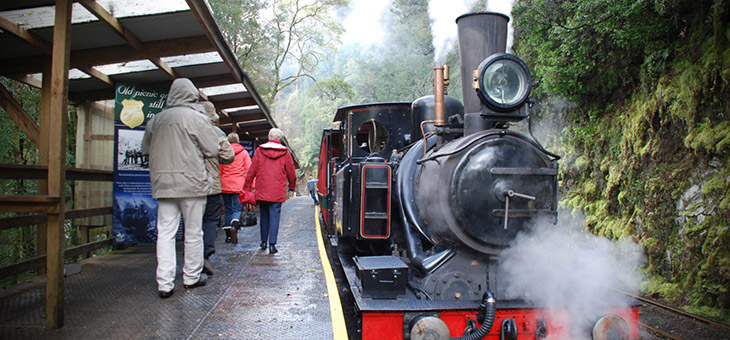The train pulls into the station, steaming, spitting, and latches onto beautifully recreated period-style carriages. The smell of the oil-burning engine, the heat of the steam, the sound of steel wheels grinding on tracks, all whet my appetite for what lies ahead.
I’m standing on the platform of the West Coast Wilderness Railway’s Queenstown Station. It’s a misty, grey day and I’m about to board the vintage vehicle for a trek into Tasmania’s wild King River region.
Our co-driver today, Darren, shows me inside the cabin – all bells and whistles, knobs, levers and dials – and explains how they keep this old train moving. He informs me that Mount Lyell No.3 – our esteemed locomotive for the day, is not powered by wood or coal, but by used oil, sourced and collected from the region’s car mechanics, machine shops and mining operations.
The railway itself is a reconstruction of the original link once used by the Mount Lyell Mining and Railway Company to ferry copper from the mines in Queenstown to the port at Regatta Point, Strahan.
Since the early 1890s, Mount Lyell’s mining operations have produced a million tonnes of copper, 750 tonnes of silver and 45 tonnes of gold.
The railroad itself is a minor miracle of engineering.
“The challenge of building a railway in this wild terrain was vast. Rugged mountains, deep valleys, rivers, rock and impenetrable forest all stood in the way of success. But Anthony Edwin Bowes Kelly [mine owner] lived by a motto – Labor Omnia Vincit. ‘We find a way, or make it’,” says the West Coast Wilderness Railway website.
“Teams of surveyors told him it couldn’t be done. The railway would need to scale an impossibly steep hill – something trains at the time simply could not do.
“Undeterred, Bowes Kelly searched for a way to make his railway a reality. Then one day he received a postcard from Germany that described a rack and pinion mechanism created by a Swiss engineer named Dr Roman Abt. That discovery would change everything.”
The Abt system uses a central rack with vertical teeth between the two standard rails. Cogs on the train with offset teeth ensure that the pinions on the locomotive driving wheels are constantly engaged with the rack. The rack and pinion system is only engaged on inclines or declines and enabled the train to carry heavy loads of copper while ascending the steep rainforest mountains.
The train is the only operating Abt rack and pinion railway in the Southern Hemisphere.
The railway transformed the fortunes of the west coast during the late 19th Century and may be the main reason Strahan even exists as a town.
While it had commercial origins, the track was also the only link for passengers between Queenstown and Strahan. Although, the ore was always top priority, and if a load needed to be taken down the mountain to make a cargo ship or meet a deadline, passengers, including schoolkids, would be left to wait for the train to return empty. Often these children could return home at midnight to then have to rise at dawn for the morning train back to school.
During my journey we stop at historic railway platforms, pan for gold at Lynchford Station (two kids strike it lucky!), traverse the deep chasm of the King River Gorge, where we stop for fabulous photo opportunities, all the while being regaled of the struggles and stories of the early west coast pioneers who lived and worked in the area.
Our steward, Debbie, has some stories of her own, and is only too willing to please everyone on board. Each passenger is made to feel special.
At Dubbil Barril we watch the drivers load the loco onto the 1950s turntable and push, by hand, the 26-tonne engine 180 degrees so it can be latched back onto the carriages for the journey home. After witnessing this feat, we meander through the rainforest walk and head back to the carriages for afternoon tea.
On the Wilderness Carriage, we are welcomed with a glass of bubbles on boarding and canapés. Hot beverages, morning tea and a light lunch are served throughout the journey.
A standard Heritage Carriage is just as comfortable and offers a choice of drinks and snacks for purchase during your journey. There’s also an optional whisky tasting for all passengers at Rinadeena Saddle.
Rack and Gorge half-day tours depart and return to Queenstown, but there’s a railway tour for all tastes, including one where you can work alongside a locomotive crew, steam up the mountain and ride the rapids of King River Gorge back down to Queenstown, or even take a steam/helicopter ride from Dubbil Barril back to Regatta Point.
The railway offers a historic glimpse of early settler west coast living, an unparalleled view of the Tasmanian rainforest and wild rivers and is a must for any Apple Isle tourist.
Related articles:
Embracing Tasmanian winter
Museum on a mission to confront
Cruising a Tasmanian treasure

